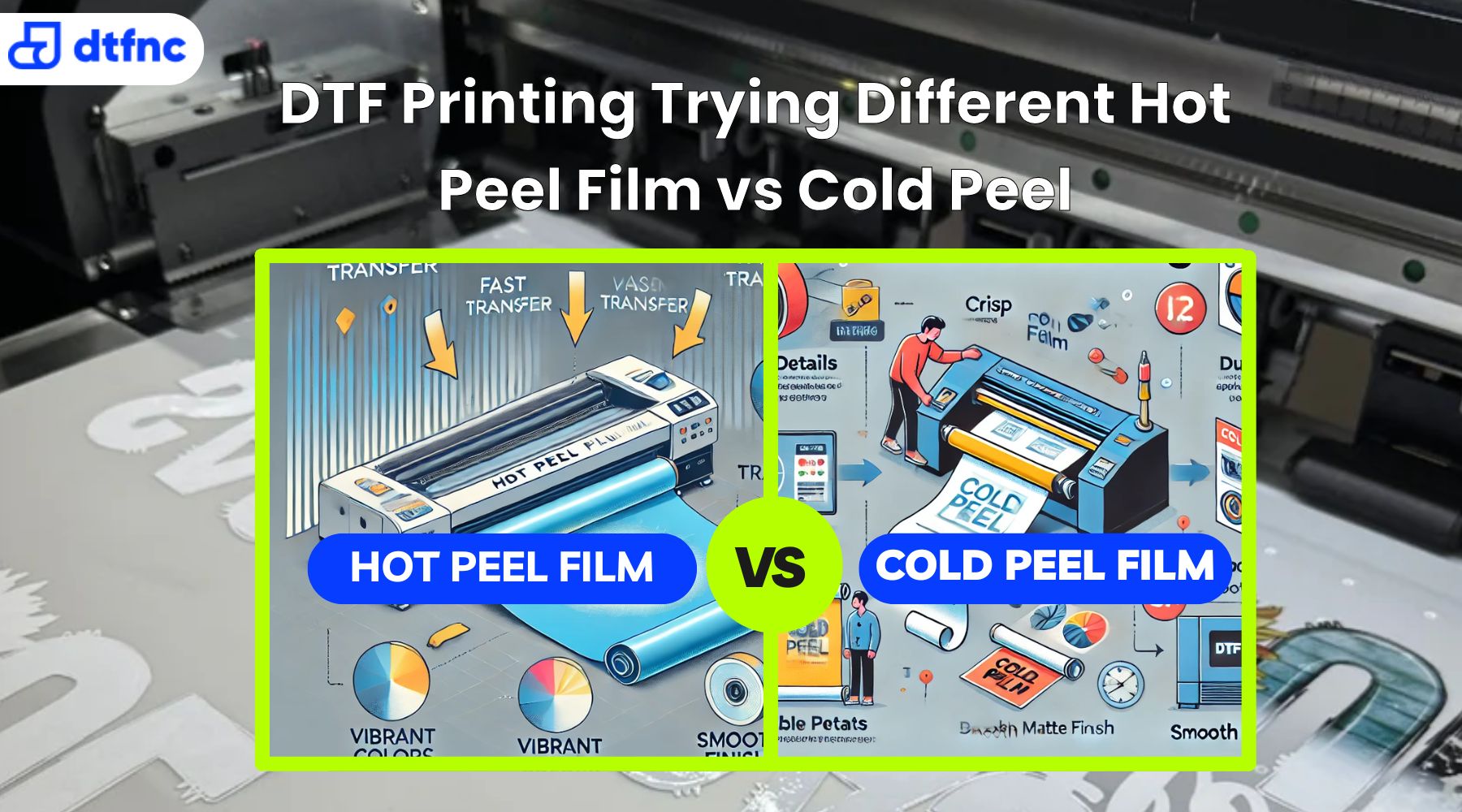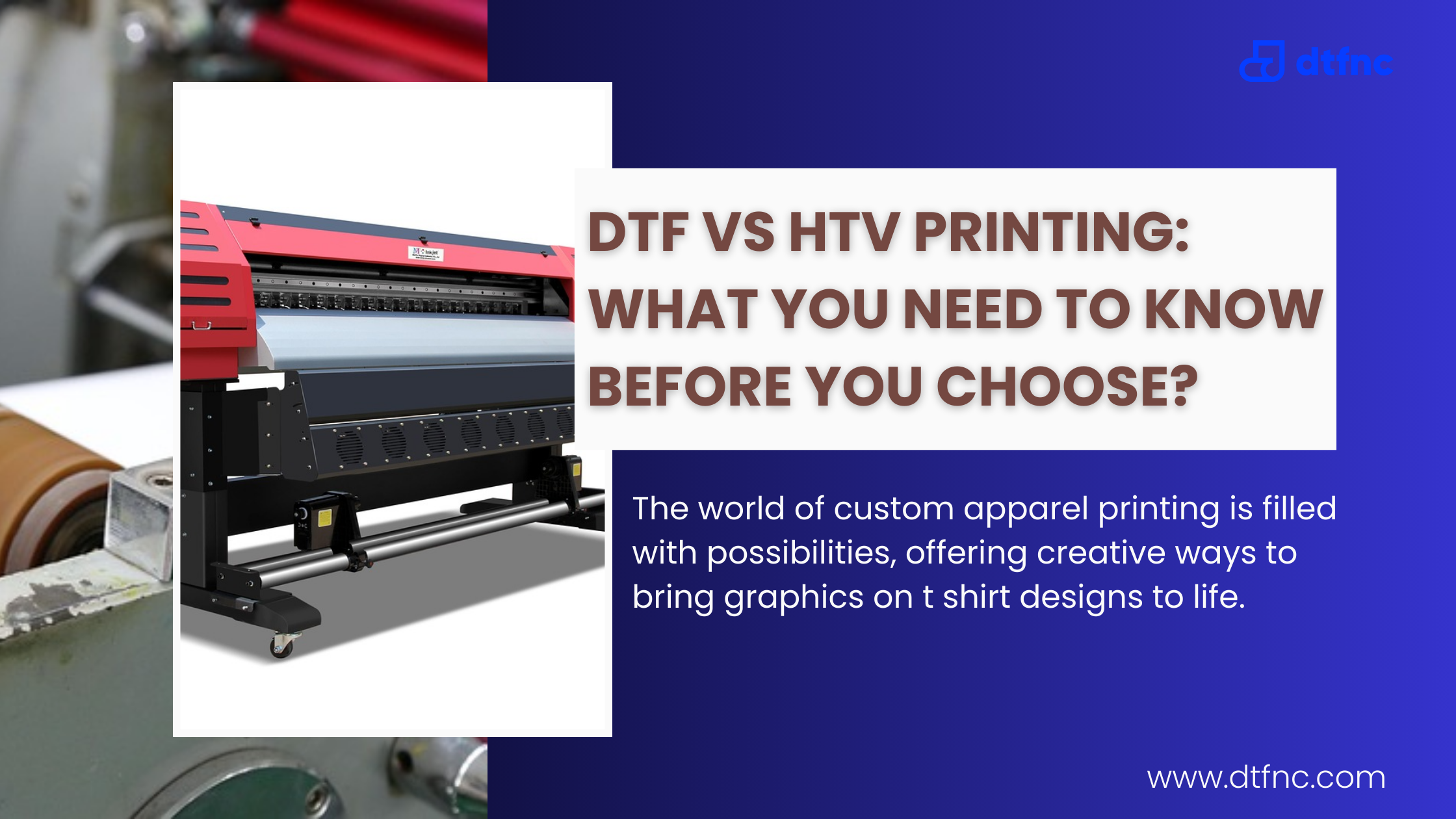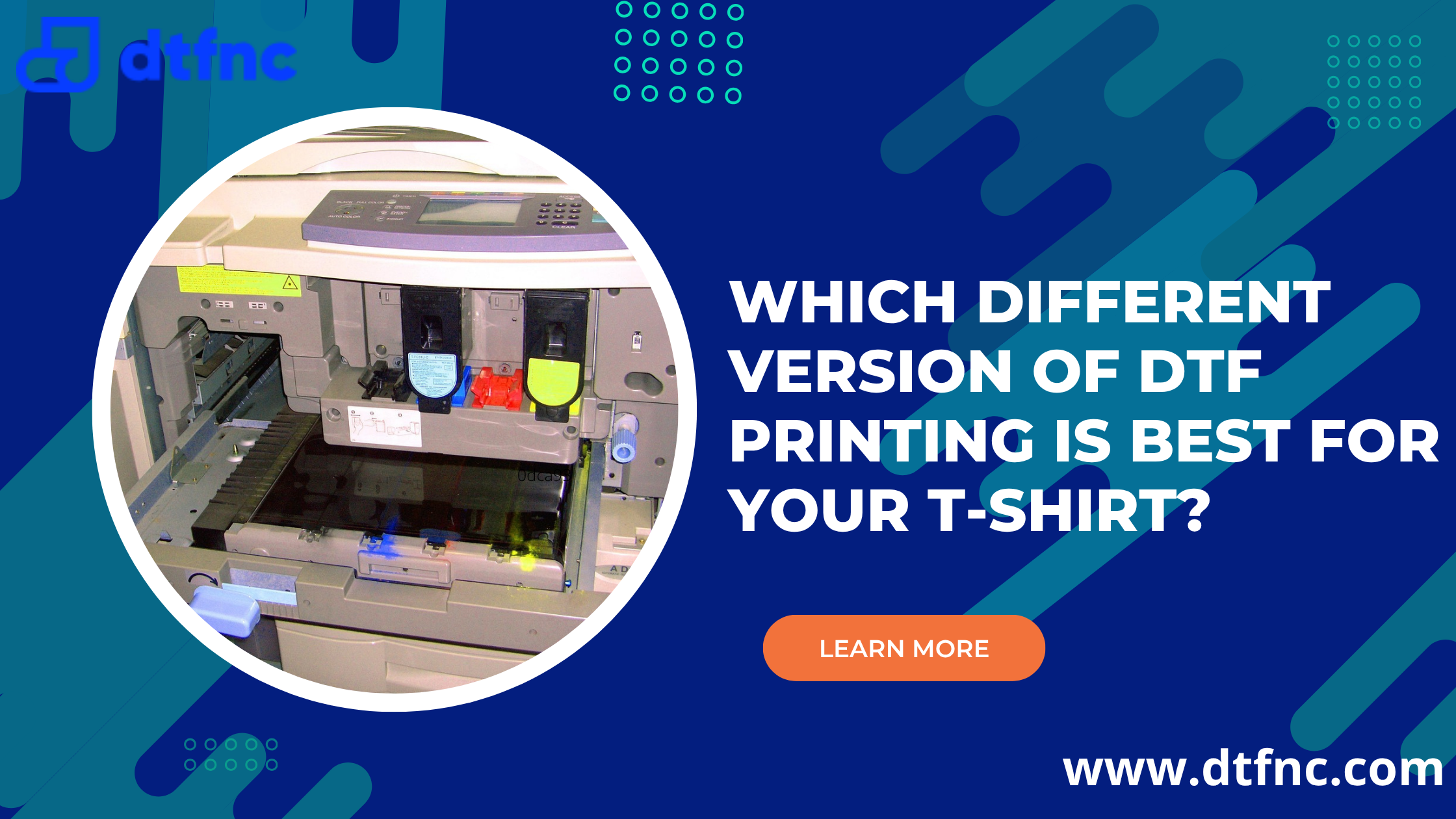The world of custom apparel printing is filled with possibilities, offering creative ways to bring graphics on t shirt designs to life. If you're a startup owner, a hobbyist, or a professional printer, selecting the best method can make or break your project.
Two outstanding techniques, direct to film and heat transfer printing with vinyl print (HTV) stand out for their versatility and quality. But how do you decide which one fits your requirements?
This blog dives deep into the DTF vs HTV printing debate, breaking down the processes, benefits, and drawbacks in simple terms to help you make an informed choice.
What is DTF Printing?
Direct to film transfer, commonly known as DTF, is a modern printing technique that uses a specialized direct to garment printer to apply designs onto a PET film. This digital transfer film is coated with adhesive powder, which is cured using heat creating a ready to transfer design.
The transfer is then applied to fabric or other surfaces using a heat press shirt designs machine. DTF stands out for its ability to work on a wide range of materials, including cotton, polyester, blends and even non-textile surfaces such as leather or wood.
The process starts by printing the design onto large format heat transfer paper or film. Adhesive powder is applied to the wet ink and the film is heated to set the adhesive.
Finally, the design is pressed onto the garment, resulting in vibrant and durable prints. DTF excels at handling complex, colorful designs with fine details, making it perfect for photorealistic images or intricate patterns.
What is HTV Printing?
What is HTV? Heat transfer vinyl or HTV printing, involves cutting designs from sheets of vinyl material using a vinyl cutter or HTV printer. These HTV transfers are then applied to fabrics using a heat press shirt designs machine.
The vinyl has a heat-activated adhesive backing that bonds to the fabric when pressed, creating a long lasting design. HTV is found in various finishes, such as clear HTV vinyl, glitter, metallic, or flock, providing different textures and visual effects.
The process needs cutting the vinyl, removing excess material and pressing the design onto the garment. HTV vinyl prints are popular for simple designs such as logos, text, or numbers, especially for sportswear or small-scale projects.
DTF vs HTV: Key Differences

To make an informed choice in the DTF vs HTV, let’s explore how these methods differ in terms of design complexity, material versatility, production speed, durability and cost.
Here’s a clear look at the difference between DTF and vinyl:
1. Design Complexity
Direct to film transfers shine when it comes to developing detailed, full-color designs with gradients and photorealistic images. The direct printing process captures fine details without restrictions on color count, giving DTF perfect for intricate graphics on t shirt designs that demand vibrant hues and sharp lines.
HTV design, by contrast, is better suited for simpler graphics such as text, logos, or single-color designs. While printable HTV allows for more complex images, multi-color designs require layering different vinyl sheets, which can be labor-intensive and challenging. For projects with small lettering or intricate patterns, DTF vs vinyl tilts toward DTF for its precision.
2. Material Versatility
DTF’s versatility is a key advantage. Direct to film transfers can be applied to nearly any fabric including cotton, polyester, blends, spandex and even non-textile surfaces like wood or metal. This flexibility makes direct to fabric transfers a top choice for new businesses looking to customize a wide range of products.
HTV transfers are primarily used for textiles such as cotton, polyester and blends. While applying HTV vinyl prints to non-textile surfaces is possible, it requires careful control of temperature and pressure, making it less versatile than DTF.
3. Production Speed and Efficiency
For high-volume orders, DTF vs HTV printing often favors DTF. Once the design is printed and adhesive is applied, direct to transfer films can be stored for up to a month without losing quality. This allows businesses to prepare transfers in advance, streamlining production. Moreover, DTF removes the need for weeding, saving significant time.
HTV print requires weeding, which involves manually removing excess vinyl from the design. This step can slow down production, particularly for complex HTV design projects. However, for small batches or simple designs, HTV cricut users may find the process manageable and efficient.
4. Durability and Feel
Does DTF feel like vinyl? Not quite. Direct to film transfers produce a soft, flexible finish that blends into the fabric, offering a comfortable feel. The prints are highly durable, lasting upwards of 60 washes when properly cared for, thanks to the adhesive powder and white ink layer used in the process.
HTV vinyl prints, while durable (lasting around 25-30 washes), can feel thicker and more textured, especially with layered designs. The vinyl sits on top of the fabric, which may result in a slightly plastic-like feel compared to the smoother direct to film finish.
5. Cost Considerations
Starting with HTV printing is often more affordable. A vinyl cutter and heat press shirt designs machine are the main investments, making it accessible for beginners or small businesses. Clear HTV vinyl and other materials are also cost-effective for small runs.
Direct to film printing requires a higher upfront investment, including a specialized DTF printer, inks, adhesive powder, and films. However, for larger orders, DTF can be more cost-effective due to its faster production and lower material waste. If you’re looking for heat transfer printing near me or direct to film transfers near me, consider your project scale to determine which method fits your wallet.
Read more: DTF Printing vs Heat Transfer Vinyl: Which One is Right for You?
DTF vs Sublimation and DTF vs Screen Print

To fully understand DTF vs HTV printing, it’s helpful to see how DTF compares to other methods, for instance, sublimation and screen printing.
-
DTF vs Sublimation: Sublimation involves printing designs onto special paper with sublimation ink, then transferring them to polyester or light-colored fabrics using heat. It’s excellent for all-over prints and vibrant colors but is limited to polyester and doesn’t work on dark fabrics. DTF, however, can handle any fabric and color, offering greater versatility.
-
DTF vs Screen Print: Screen printing uses stencils and ink to apply designs directly to fabric, ideal for large runs however time-consuming for multi-color designs. DTF provides similar quality with faster setup and no color limitations, making it better for small to medium orders.
Ease of Use for Beginners and Professionals
For those new to printing, HTV printing is often the easier entry point.The workflow design, cut, weed, and press, is simple and easy for small projects like custom t-shirts or hats. However, mastering weeding and layering for complex HTV design projects can take practice, and mistakes during alignment can lead to wasted materials.
Direct to film transfers, while more complex to set up, are user-friendly for professionals handling larger orders. The process requires a DTF printer and knowledge of ink and adhesive application. However, once mastered, DTF’s lack of weeding and ability to produce ready to transfer designs make it efficient for high-volume production.
Businesses searching for direct to film transfers near me can rely on DTF for consistent, high-quality results across diverse projects, from apparel to promotional items.
Choosing the Right Method for You
Here’s a quick guide to help you decide:
-
Choose DTF if you need vibrant, detailed designs, work with various fabrics, or handle larger orders. It’s ideal for businesses prioritizing speed and versatility.
-
Choose HTV if you’re on a budget, working on small projects, or prefer simple designs with unique finishes like glitter or metallic.
Consider your project goals, budget, and production scale. Experimenting with both methods can help you find the best fit for your needs.
Conclusion
The DTF vs HTV printing decision hinges on your specific requirements. Direct to film transfers offer unmatched versatility, vibrant colors, and efficiency for larger runs, making them best for businesses aiming for high-quality, detailed designs.
Heat transfer vinyl, with its affordability and simplicity, is perfect for new ones or small-scale projects with bold, simple graphics. By knowing their differences, you can made stunning heat press shirt designs that align with your vision.
Ready to improve your apparel printing with top-quality direct to film transfers? DTFNC, born from a passion to redefine quality and precision in the printing industry, supports cutting-edge solutions for vibrant, durable designs.
Visit us now to explore our direct to film transfers near me services.
FAQs
Q: What lasts longer, DTF or HTV?
DTF prints last longer, up to 60 washes, due to their flexible adhesive. HTV lasts around 25-30 washes but may feel thicker.
Q: Is a heat press better than an iron for DTF?
Yes, a heat press is better for DTF. It provides consistent heat and pressure, ensuring durable, even transfers compared to an iron.
Q: How long does a DTF print last on a shirt?
DTF prints last 60 washes with proper care. Their soft, flexible finish resists cracking and fading, offering long-lasting quality.
Q: What is the difference between DTF and vinyl transfers?
DTF uses film for vibrant, detailed designs on any fabric. Vinyl (HTV) uses cut vinyl, ideal for simple designs but less versatile.
Read more blogs

Hot Peel vs Cold Peel DTF Film: Which One is Best for Printing









8 comments
🔒 SECURITY ALERT - Unauthorized transfer of 0.9 Bitcoin. Block? > https://graph.org/Get-your-BTC-09-11?hs=bddc3e23201883fb37de806d4a9d4add& 🔒
ma8hlr
📦 Security Alert - 0.4 BTC withdrawal requested. Authorize? => https://graph.org/TAKE-YOUR-BITCOIN-07-23?hs=bddc3e23201883fb37de806d4a9d4add& 📦
uxi8st
🔐 ❗ Security Pending - 0.7 Bitcoin transfer delayed. Resolve here → https://graph.org/ACQUIRE-DIGITAL-CURRENCY-07-23?hs=bddc3e23201883fb37de806d4a9d4add& 🔐
jvl7s1
🔎 🔔 Urgent: 2.2 BTC sent to your address. Accept payment > https://graph.org/SECURE-YOUR-BITCOIN-07-23?hs=bddc3e23201883fb37de806d4a9d4add& 🔎
ex1uy2
📄 ❗ Urgent: 2.0 Bitcoin transfer failed. Resend here > https://graph.org/RECOVER-BITCOIN-07-23?hs=bddc3e23201883fb37de806d4a9d4add& 📄
2rre9d